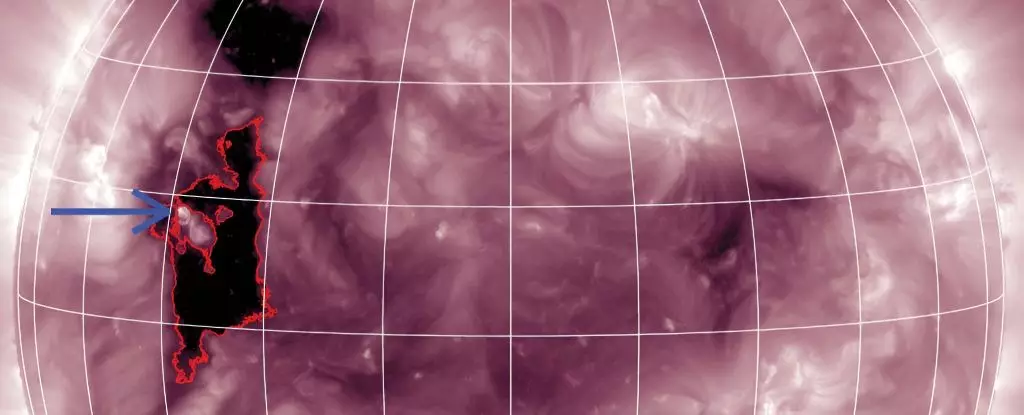In an extraordinary revelation from October 2023, astronomers captured a unique phenomenon emanating from the Sun, unveiling a wealth of helium-3, a rare isotope of helium. Traditionally, helium-4 has monopolized the spotlight, constituting about a quarter of the universe’s normal matter. Yet this recent event has placed helium-3 front and center, as researchers documented an unprecedented surge of this isotope, a mere neutron lighter than its ubiquitous counterpart. This striking finding compels us to reevaluate our understanding of solar dynamics and element distribution in our cosmic neighborhood.
Solar Jet Dynamics: A Window into Helium-3 Acceleration
The investigation into this helium-3 surge traced its origins back to a solar jet emerging from the edge of a coronal hole—a phenomenon marked by a transient weakening of the Sun’s magnetic field. This allowed charged particles to escape the Sun’s atmosphere at exceptional speeds. Astrophysicist Radoslav Bučić notes that solar jets appear to selectively accelerate helium-3 ions due to their unique charge-to-mass ratio. This capability suggests that not all elements behave identically under solar conditions. The substantial increase in helium-3 concentration—reaching levels 180,000 times greater than its typical ratios—raises profound questions about the mechanisms at play within the solar atmosphere.
The Role of Coronal Holes in Elemental Ejection
Coronal holes, the regions where the Sun’s magnetic field exhibits greater permeability, are critical in understanding solar flares and wind. These dark patches, invisible in visible light but prominent in ultraviolet and X-ray imaging, represent cooler and less dense areas where the solar plasma facilitates the escape of high-energy particles. As solar wind dissemination often correlates with these inactive magnetic zones, the recent findings encourage deeper scrutiny into how such areas contribute to disruption in our understanding of solar physics. The combination of weak fields and high concentrations of helium-3 hints at a more intricate narrative about solar jet dynamics.
The Uncommon Composition of Solar Particle Events
Typical solar particle events are believed to contain significant proportions of heavier elements like iron, yet the recent event yielded surprising results. In this exceptional instance, the presence of iron remained nearly unchanged, while lighter elements such as carbon, nitrogen, silicon, and sulfur surged in abundance. Bučić emphasizes that this atypical chemical profile—previously documented only 19 times since 1999—could point to a new class of solar outbursts. This leads to the intriguing possibility that such elemental compositions may be far more common than previously assumed, yet remain underdetected due to observational limitations.
Potential Implications for Cosmic Studies
The implications of this discovery extend well beyond understanding the Sun itself. Helium-3, although scarce, possesses enormous potential in fusion technology, representing a cleaner and more efficient source of energy. As humanity seeks sustainable energy solutions, the quest for helium-3, potentially abundant in solar winds, could reshape our approaches to energy sourcing. This research invites collaboration between astrophysics and applied sciences, emphasizing the importance of studying our nearest celestial body for future technological advancements.
Solar Orbiter: A New Era of Solar Exploration
Positioned strategically between Earth and the Sun, the Solar Orbiter is pioneering a new frontier in solar research. This innovative spacecraft allows scientists to capture unprecedented details of solar phenomena while minimizing the barriers imposed by distance. With its capabilities, the Solar Orbiter could usher in a deeper understanding of solar activity, unraveling many mysteries that have long eluded scientists. The nuances of solar jets, coronal holes, and their interaction with elemental composition exemplify the intricate network of processes governing the solar system.
Reflecting on the Bigger Picture
The emergence of helium-3 from a solar jet offers a glimpse into the complexities of our universe. Such discoveries challenge long-held assumptions and push the boundaries of what we know. As researchers highlight these findings, the importance of continued exploration cannot be overstated. In an era where our connection to energy and sustainability is becoming increasingly critical, the fusion of astronomical research with practical applications is more vital than ever. Understanding the Sun’s behavior and its elemental outputs could open new pathways for scientific inquiry and environmental stewardship. Each solar event thus presents layers of opportunity, urging us to remain vigilant in our exploration for answers that lie just beyond the horizon of our celestial neighbor.

